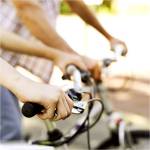30 Mar Bikes, cars and the law

Despite the occasional snow flurry and overnight freezing, cyclists are emerging from their weather-imposed hiatus to once again navigate the roads of Maine and New Hampshire. It seems the true end of winter comes when you see bikes back on the road – and with them, a need for safer driving practices for everyone – cyclists and drivers alike. So, what do the numbers 800 and 515,000 have in common?
In 2010, there were 800 bicyclists killed in the United States and an estimated 515,000 bike-related injuries that required emergency room care according to the U.S. Centers for Disease Control and Prevention. The CDC also notes that half of those injured cyclists were under the age of 20 with 26,000 sustaining traumatic brain injuries. Unfortunately, about half of children age 5 to 14 do not wear helmets.
Just to give everyone a running start on the rules of the road in our region, the law in both Maine and New Hampshire states that cyclists must obey the same traffic laws as vehicles: stop at stop signs and red lights, yield to pedestrians at crosswalks and yield to traffic when entering the road. In addition,
- Drivers must provide a minimum of three feet between the vehicle and the cyclist when passing and may not make a right hand turn in front of a cyclist unless it can be done with reasonable safety.
- Cyclists must ride with traffic, not against it.
- When passing a cyclist, drivers may cross the center line in a no-passing zone if it is safe to do so in order to provide the three-foot buffer.
- Cyclists are expected to ride on the right side of the road as is “practicable” but may legally take more or all of the travel lane including setting up for a left turn, passing other vehicles or avoiding unsafe road conditions.
- Drivers “may not unnecessarily sound a signaling device or horn” as it could startle a cyclist and cause a crash.
- Cyclists must have and use headlights at night as well as rear reflectors and foot/ankle/pedal reflectors.
- Drivers may open car doors only after checking to see that it can be done safely.
- In Maine and New Hampshire, cyclists under age 16 MUST wear a helmet – and we encourage all cyclists to do so, as well.
The NH Department of Transportation also offers a video link to demonstrate the rules of the road.
Road Conditions: Having suffered through one of the coldest winters on record, the roads in our region have taken a beating and are covered in tons of sand. Also, the deep frost that penetrated road beds is playing havoc as the pavement heaves and the tar gets chipped away into sometimes cavernous potholes. Though road shoulders and travel lanes will be cleaned and repaired to enable safe passage of bikes, it is these early months of spring that drivers and cyclists must slow down and use common sense.
Though the law clearly favors the safe passage of cyclists including riding in the middle of a traffic lane, no law can protect the human body atop a 20 pound bike when it collides with a two or three ton vehicle. Cycling commuters and recreational bikers should survey their routes to be sure they are free of substantial impediments such as potholes, sand, glass and other debris that can pop a tire or result in a dangerous wipe out.
Cyclists also should invest in brightly colored reflective gear and lights that alert drivers that a biker is sharing the road.
Perhaps most important, parents need to coach their kids and model appropriate behavior. If mom or dad doesn’t wear a helmet, why should the kids? It’s important to practice what you preach. A family bike ride early in the season on a weekend morning can give parents a chance to have fun and teach while they ride. Also, parents can point out road hazards and good or bad behavior while driving in the car to illustrate how bikers and drivers need to get along.
Take precautions now to ensure you have a fun and safe riding season.



